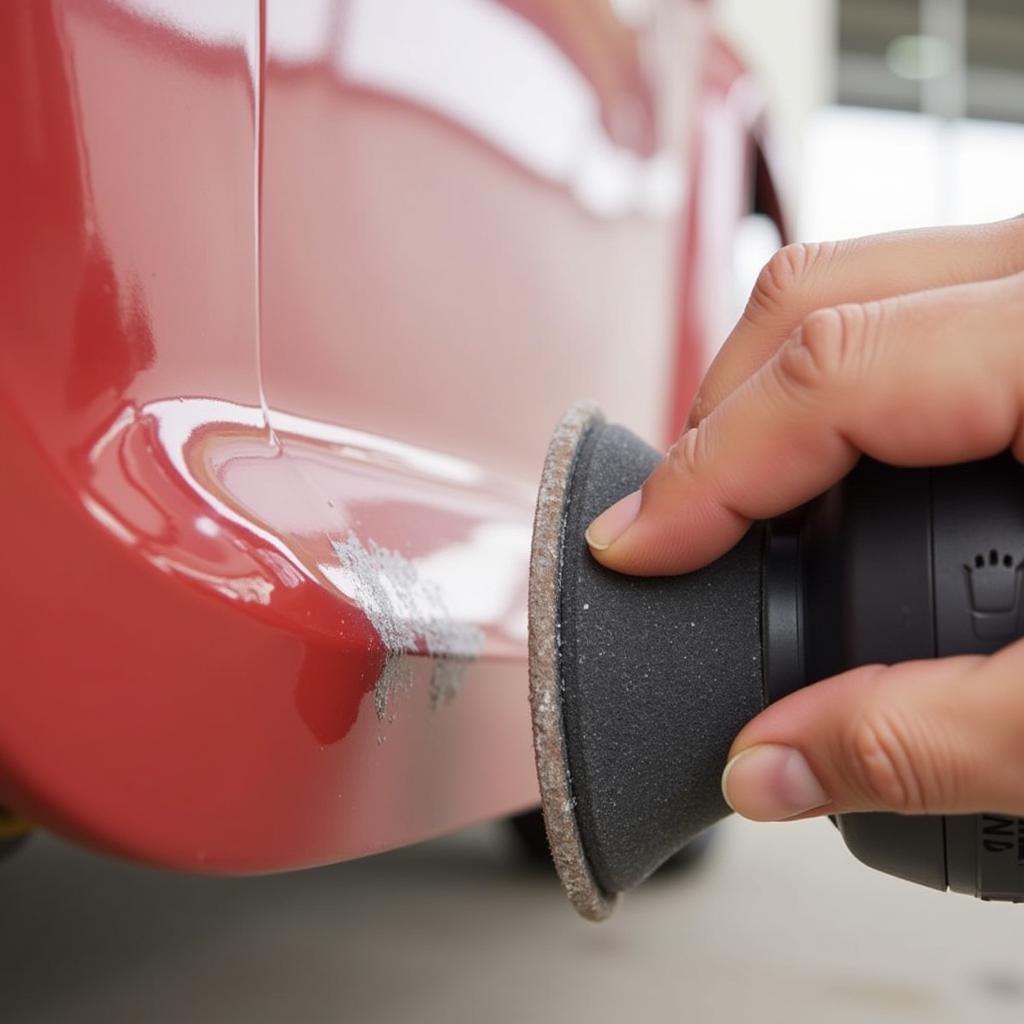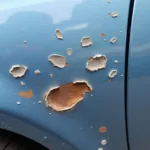Fixing those annoying small paint chips on your car can seem daunting, but with the right approach, it’s a manageable DIY project. This guide provides a comprehensive step-by-step process on how to repair small paint chips on car, saving you a costly trip to the body shop and keeping your car looking its best.
Identifying the Chip and Gathering Supplies
Before you begin to repair small paint chips on car, assess the damage. Is it a superficial scratch, a chip that’s reached the primer, or has it gone down to the bare metal? Knowing the extent of the damage dictates the necessary approach. For minor chips, you’ll need items like touch-up paint, rubbing compound, and a microfiber cloth. Deeper chips require primer, sandpaper, and potentially a clear coat.
Prepping the Area for Repair
Cleaning the chipped area is crucial for proper adhesion of the repair materials. Use a car wash soap and water solution to remove dirt and grime. Dry the area thoroughly. For deeper chips that have reached the metal, lightly sand the area with fine-grit sandpaper to create a smooth surface for the primer to adhere to. This step is vital when you want to know how to repair small paint chips car down to metal.
Applying the Touch-Up Paint and Primer (If Necessary)
If the chip has reached the metal, apply a thin layer of automotive primer to the affected area. Let it dry completely before proceeding. For all chips, apply the touch-up paint in thin coats, allowing each coat to dry before applying the next. Patience is key here; avoid the temptation to apply thick coats, as this can lead to an uneven finish. how to repair small chips in car paint will provide more information on handling smaller chips, which tend to need less attention in layering.
How to Avoid Bubbles in Touch-Up Paint?
Applying the paint in thin layers is the most effective way to prevent bubbles. Applying too much paint at once will trap air underneath and cause the paint to bubble as it dries. Be patient and allow each layer to dry completely.
How to Choose the Right Touch-Up Paint?
Choosing the correct touch-up paint is essential for a seamless repair. The paint code for your car is usually located on a sticker inside the driver’s side doorjamb or in the owner’s manual. Use this code to purchase the exact match for your car’s paint color.
Smoothing and Blending the Repair
After the paint has dried completely, you may notice a slightly raised area where the touch-up paint was applied. Use fine-grit sandpaper (2000-3000 grit) and rubbing compound to carefully level the repaired area with the surrounding paint. how to repair small paint chips on car offers a deeper look into the process of smoothing and blending touch-up paint.
 Sanding Car Paint Chip Repair
Sanding Car Paint Chip Repair
Applying Clear Coat (If Necessary)
If your car has a clear coat finish, you’ll need to apply a thin layer of clear coat over the repaired area after the touch-up paint has dried and been leveled. This helps protect the repair and provides a uniform sheen. repair small paint chips on car covers both small chip repair as well as the application and care needed for clear coat.
Final Polishing and Waxing
Once the clear coat has dried (if applicable), polish the entire area with a polishing compound to restore the shine. Finally, apply a coat of wax to the repaired area and surrounding paintwork for added protection. repair small white chips car paint specifically addresses white paint chip repair where these final steps are even more crucial for maintaining a pristine look.
“A properly repaired paint chip can be virtually invisible,” says automotive expert, James Miller. “Taking your time, using thin coats, and properly matching the paint color are essential for a seamless repair.”
“Remember, preventative measures such as regular washing and waxing can help minimize the occurrence of paint chips in the first place,” adds Susan Davis, a seasoned auto detailer.
In conclusion, repairing small paint chips on your car is a relatively straightforward process that can save you money and maintain your car’s appearance. By following the steps outlined in this guide on how to repair small paint chips on car, you can achieve professional-looking results. how to repair small paint chips car down to metal will aid in more extensive damage repair for deeper chips.
FAQ
-
How long does touch-up paint take to dry? Typically, touch-up paint takes about 30-60 minutes to dry to the touch.
-
Can I repair paint chips in direct sunlight? No, it’s best to repair paint chips in a shaded area to prevent the paint from drying too quickly and potentially bubbling.
-
What if the chip is larger than a dime? Larger chips may require professional repair by a body shop.
-
Can I use nail polish to repair a paint chip? Using nail polish is not recommended, as it won’t match your car’s paint and may damage the surrounding finish.
-
Can I wash my car after repairing a paint chip? It’s best to wait at least 24 hours before washing your car after repairing a paint chip.
-
What if I don’t know my car’s paint code? Consult your owner’s manual or check the driver’s side doorjamb for a sticker that contains the paint code.
-
What’s the difference between rubbing compound and polishing compound? Rubbing compound is more abrasive and used for leveling the paint, while polishing compound is finer and used to restore shine.
For further insights on car maintenance, check out other articles on our website. Need professional help with your car’s paint? Reach out via WhatsApp: +1(641)206-8880 or Email: [email protected]. Our 24/7 customer support team is here to assist you.

